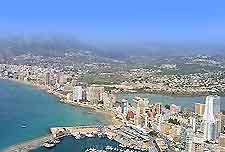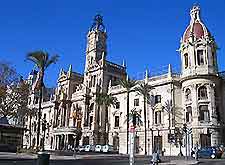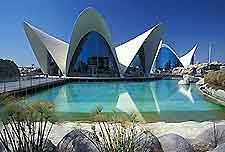Valencia Tourist Information and Tourism
(Valencia, Valencian Community, Spain)

The third-biggest city in the whole of Spain, Valencia is a particularly progressive city, with spectacular architecture, both old and new. In recent years, Valencia has worked hard to reinvent itself and succeeded on all levels, with the introduction of the stunning Valencia City of Arts and Science (Ciudad de las Artes y las Ciencias), a true cultural complex which has quickly become the city's premier tourist attraction.
Valencia is also known for its superb climate, with the vast Valencia region containing a number of stunning sandy beaches, and more than 500 km / 310 miles of appealing coastline. The city of Valencia is famous for being the home of paella, featuring many superb restaurants and fine dining throughout the city, including a host of Tapas bars in the Old Quarter, around the spacious Plaza de la Reina.
The tourism industry has never been more important in Valencia and the city is actively encouraging tourism at all levels. The main tourist information centres in Valencia include the Regional Tourist Information Office on Calle Paz, the Train Station Tourist Office on Xàtiva, the Valencia Town Hall Tourist Information Office on the Plaza del Ayuntamiento, and the Teatro Principal Tourist Office along the Calle Poetra Querol. All of Valencia's tourist information outlets offer a large selection of leaflets and general advice on how to make best use of your time in the city. The tourism bureaus also provides maps, showing how Valencia is divided into a number of notable regions and districts, which include Valencia's Old Quarter (Parte Vieja), Cánovas district, and its University district - a lively part of the city, centred around the historic Universitat de València.

In recent years, Valencia has become an extremely popular tourist destination, with many hotels throughout the city. Accommodation is particularly busy in the summer months, and during the city's most popular festivals, which include February carnivals, the Las Fallas in March, Holy Week and Easter celebrations, Corpus Christi in June, and the San Juan bonfires towards the end of June. Many of Valencia's main hotels are located close to the coastline and beaches, university campus, around the Old Quarter, in the Barrio del Carmen area, and near to the Plaza del Ayuntamiento. More information about
Valencia Hotels.
The unique Valencia City of Arts and Science contains four main attractions - L'Hemisfèric Planetarium - featuring a planetarium, modern cinema and astronomy information; Palacio de las Artes Reina Sofia- a superb leisure complex promoting Valencia's arts and cultures scene; Parque Oceanográfico - full of marine life, including Beluga whales, dolphins, penguins and a host of colourful tropical fish; and Valencia's Museo de las Ciencias Principe Felipe - a vast museum and striking building, full of scientific information and interactive technology.
Other notable tourist attractions in Valencia include the Miguelete Tower - a tall cathedral belltower, standing high above the city and offering panoramic views of the Valencia area; Nicolau Primitiu Library - a 15th-century building containing a large collection of books, documents and local artefacts; Palacio de Congresos de Valencia - a major conference centre, hosting many of Valencia's most prominent events and exhibitions; Palacio de la Música - the 'Music Palace', known for its contemporary design and popular concerts; and Palacio de Justicia - a grand palace which has gained the prestigious title of 'National Historic and Artistic Monument'.

Landmarks and further tourist attractions in Valencia include the Plaza Redonda - a circular spot where there are plenty of shops and places to eat outdoors; Plaza de Manises - a particularly historic square standing in the heart of Valencia's Old Quarter; Plaza de Toros - the Valencia bullring, an impressive structure dating back to the mid-19th century; Plaza de la Virgen - a popular place to shop, known for its grand fountain and surrounding palatial buildings; and Plaza de la Almoina - a large public square situated in Valencia's Old Quarter, where significant Roman remains have been discovered.
Also worthy of a visit, other top tourist attractions include the Antigua Universidad de Valencia - the 'Old University' of Valencia, comprising a number of beautiful, Neo-classical buildings; the Ayuntamiento - the 18th-century City Hall, which has the appearance of the grand palace, hosting the annual mascletá fireworks display; Lonja - a notable and imposing 13th-century building now listed as a World Heritage Site; Portal de Valldigna - remains and ruins of Valencia's ancient 13th-century surrounding wall ; Puente del Mar - an ancient 'Sea Bridge', dating back over 400 years, with ten large arches; and Puerto de Valencia - the main port, responsible for much of Valencia's prosperity and wealth over the years, offering various cruises. More information about
Valencia Tourist Attractions and
Valencia Landmarks.
Some of Valencia's main museums and art galleries include Museo de Ciencias Naturales - Valencia's Museum of Natural Sciences, with many fossils, dinosaur skeletons and information about evolution; Museo de Prehistoria y Arqueologia - the Museum of Archeology, containing important collections of local archaeological treasures; Museo de la Ciudad - City Museum, celebrating the rich heritage of Valencia, with information about the area's Roman past; Museo Taurino - the Valencia Bullfighting museum, where you can find an impressive collection of matador costumes and local memorabilia; the Valencian Institute of Modern Art - with an array of stunning modern works of art, including large paintings and sculptures in various mediums; and Valencia's San Pious V Museum of Fine Arts - known for its outstanding collection of 15th-century paintings and historical art works. More information about
Valencia Museums and
Valencia Art Galleries.
Tourist attractions located nearby Valencia include the lively coastal resort of Benidorm, with an endless selection of beaches, hotels, restaurants, bars and theme parks; Alicante - to the south of Valencia, famous for being home to the 9th-century Castillo de Santa Bárbara and tiled seafront promenade; the Balearic Islands - to the east of Valencia, including the party island of Ibiza, which offers a stunning coastline and over 50 beaches; the town of Paterna - situated on the outskirts of Valencia, featuring a famous fireworks extravaganza every August; Sagunto - a popular town to the north of Valencia, with tourist attractions including a medieval castle and Roman remains; Bunol - a small town most famous for its annual 'Battle of the Tomatoes' each summer, where thousands of people throw enormous piles tomatoes at each other; and Dehesa del Saler - a popular excursion from Valencia, offering a number of sandy beaches, walking trails, golf and leisure activities. More information about
Valencia Attractions Nearby.
More Valencia Information / Fast Facts and Orientation
Valencia, Spain
- Country: Spain
- Location: Valencia Province, Valencian Community
- Status: city
- Area: approximately 52 square miles / 135 square kilometers
- Population: approximately 808,000
- Language: Spanish
- Currency: Euro (EUR)
- Time zone: 1 hour ahead of Greenwich Mean Time (GMT)
- Country dialing code: +34
- Telephone area code: 96
- Religion: various religions
- Average daily Valencia January temperature: 15°C / 59°F
- Average daily Valencia July temperature: 29°C / 84°F
 The third-biggest city in the whole of Spain, Valencia is a particularly progressive city, with spectacular architecture, both old and new. In recent years, Valencia has worked hard to reinvent itself and succeeded on all levels, with the introduction of the stunning Valencia City of Arts and Science (Ciudad de las Artes y las Ciencias), a true cultural complex which has quickly become the city's premier tourist attraction.
The third-biggest city in the whole of Spain, Valencia is a particularly progressive city, with spectacular architecture, both old and new. In recent years, Valencia has worked hard to reinvent itself and succeeded on all levels, with the introduction of the stunning Valencia City of Arts and Science (Ciudad de las Artes y las Ciencias), a true cultural complex which has quickly become the city's premier tourist attraction. In recent years, Valencia has become an extremely popular tourist destination, with many hotels throughout the city. Accommodation is particularly busy in the summer months, and during the city's most popular festivals, which include February carnivals, the Las Fallas in March, Holy Week and Easter celebrations, Corpus Christi in June, and the San Juan bonfires towards the end of June. Many of Valencia's main hotels are located close to the coastline and beaches, university campus, around the Old Quarter, in the Barrio del Carmen area, and near to the Plaza del Ayuntamiento. More information about Valencia Hotels.
In recent years, Valencia has become an extremely popular tourist destination, with many hotels throughout the city. Accommodation is particularly busy in the summer months, and during the city's most popular festivals, which include February carnivals, the Las Fallas in March, Holy Week and Easter celebrations, Corpus Christi in June, and the San Juan bonfires towards the end of June. Many of Valencia's main hotels are located close to the coastline and beaches, university campus, around the Old Quarter, in the Barrio del Carmen area, and near to the Plaza del Ayuntamiento. More information about Valencia Hotels. Landmarks and further tourist attractions in Valencia include the Plaza Redonda - a circular spot where there are plenty of shops and places to eat outdoors; Plaza de Manises - a particularly historic square standing in the heart of Valencia's Old Quarter; Plaza de Toros - the Valencia bullring, an impressive structure dating back to the mid-19th century; Plaza de la Virgen - a popular place to shop, known for its grand fountain and surrounding palatial buildings; and Plaza de la Almoina - a large public square situated in Valencia's Old Quarter, where significant Roman remains have been discovered.
Landmarks and further tourist attractions in Valencia include the Plaza Redonda - a circular spot where there are plenty of shops and places to eat outdoors; Plaza de Manises - a particularly historic square standing in the heart of Valencia's Old Quarter; Plaza de Toros - the Valencia bullring, an impressive structure dating back to the mid-19th century; Plaza de la Virgen - a popular place to shop, known for its grand fountain and surrounding palatial buildings; and Plaza de la Almoina - a large public square situated in Valencia's Old Quarter, where significant Roman remains have been discovered.